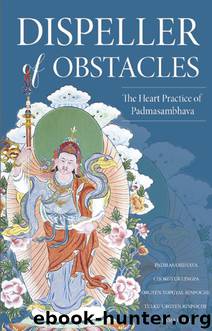Dispeller of Obstacles: The Heart Practice of Padmasambhava by Jamyang Khyentse Wangpo Padmasambhava Guru Rinpoche Chokgyur Lingpa Lama Pema Tashi Putsi

Author:Jamyang Khyentse Wangpo, Padmasambhava Guru Rinpoche, Chokgyur Lingpa, Lama Pema Tashi Putsi
Language: eng
Format: epub
ISBN: 9789627341963
Publisher: Rangjung Yeshe Publications
Published: 2014-09-22T00:00:00+00:00
THE THREE PRINCIPLES OF VISUALIZATION
The vital essence of development stage is summarized in three principles: vivid presence, pure recollection, and stable pride. Vivid presence means that your visualization is as clear and distinct as the reflection of the sky on the surface of a smooth lake. It is simply a vivid, insubstantial presence that is mentally visible and not made of any material substance. Vivid presence also means that the visualization is not vague, blurred, incomplete, or mixed up. It is complete, distinct, and clear.
The Light of Wisdom, Volume II, describes the steps of development stage in great detail, which one can apply in a very expedient, progressive order until one achieves certain meditative experiences. But one practical approach is to use a consecrated tangka or copy of one as a support for your visualization. Study the painting, then close your eyes and visualize as much as you can remember. Then open your eyes and look at the tangka again. After a bit, again close your eyes and visualize the deity to the best of your ability. Growing accustomed like that can be quite helpful in the beginning, and after a while you will not need to use the tangka at all. You will be able to just let all of it appear naturally in your mind’s eye. At first, you visualize the deity with his retinue in front of you, but when you have become adept at the visualization, you imagine yourself as the central deity surrounded by your retinue. Over time, your mind will become totally flexible, and then you can emanate, multiply, and so forth. Anything is possible.
Stable pride is the confidence and insight that the deity is none other than buddha nature itself; in other words, the nature of this mind is the deity. You need to realize that there is no other deity apart from that. As we are veiled by ignorance, we do not recognize this at first. The whole purpose of yidam practice is to remove this veil. When the veil has been lifted, we recognize the fact that we ourselves are the deity. According to Mahayoga, one never thinks of the deity as better than oneself. That’s a very important point. If you think you and the deity are at all different in status or quality, you will be further nurturing your notions of duality, and you will never accomplish the deity.
The pure recollection of symbolism involves a lot of detail, as every feature of the deity has a specific meaning. The face, arms, attributes, ornaments, seat, palace, and so forth, are all symbolic. However, we can summarize all this into one key point: the deity is the state of awareness-emptiness, and all the aspects of the visualization are the naturally occurring expression of emptiness. Neither the deity nor its mandala has any concrete reality.
If you are a practitioner of the highest capacity, then it is best to visualize the entire retinue distinctly and completely. If, however, you have not fully mastered
Download
This site does not store any files on its server. We only index and link to content provided by other sites. Please contact the content providers to delete copyright contents if any and email us, we'll remove relevant links or contents immediately.
| Anthropology | Archaeology |
| Philosophy | Politics & Government |
| Social Sciences | Sociology |
| Women's Studies |
Welcoming the Unwelcome by Pema Chodron(637)
Bardo or Not Bardo by Antoine Volodine(560)
Dzogchen by The Dalai Lama(555)
Taming the Tiger Within by Thich Nhat Hanh & Pritam Singh(512)
A Step Away from Paradise: The True Story of a Tibetan Lama's Journey to a Land of Immortality by Shor Thomas(508)
0307731871 (N) by Elizabeth Esther(506)
The Tibetan Book of the Dead by Dorje Gyurme & Coleman Graham(503)
The Six Perfections by Lama Zopa Rinpoche(500)
Awaken Every Day by Thubten Chodron(491)
A Guided Tour of Hell by Samuel Bercholz(484)
The Compassion Book by Pema Chodron(465)
A Death on Diamond Mountain: A True Story of Obsession, Madness, and the Path to Enlightenment by Scott Carney(441)
A Direct Path to the Buddha Within by Klaus-Dieter Mathes(432)
Pointing Out the Great Way: The Stages of Meditation in the Mahamudra Tradition by Brown Ph.D. Daniel & Robert Thurman(431)
The Psychedelic Experience by Leary-Alpert-Metzner(430)
Wisdom Energy: Basic Buddhist Teachings by Jonathan Landaw & Lama Yeshe & Lama Zopa Rinpoche(385)
Surviving The Dragon by Arjia Rinpoche(383)
Meditations on Living, Dying, and Loss by Graham Coleman Thupten Jinpa(381)
The Heart of Unconditional Love by Tulku Thondup(378)
